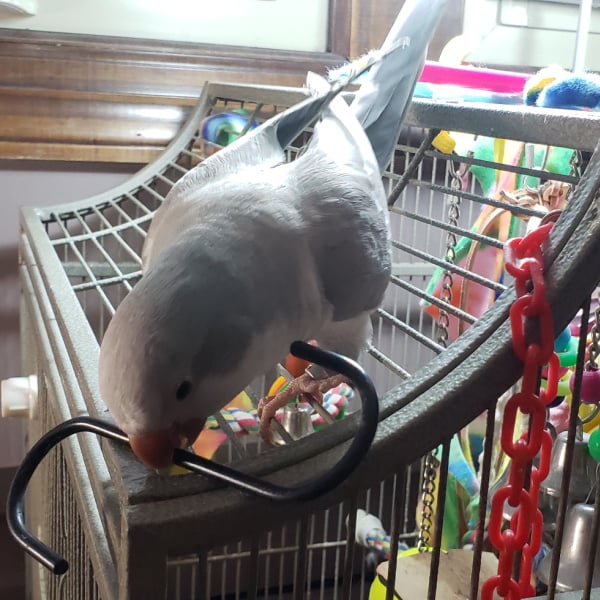
How Can I Achieve Better Birdcage Environments for My Birds?
Last Updated on by Mitch Rezman
Hey there, here for the brunch, but I’d like to speak to the manager, I just have a question or two before sitting down:
So we have a 2 bird, 2 human family.
The littlest one, a GCC named Pz is the comedian and energy ball of the group, with tons of personality packed into a 70gram feather suit.
Our sanity these days hinges upon making sure the bird children are well taken care of, as we spend all our days with them now and find it very enriching to be attentive to their unique needs and the interesting ways in which they communicate them to us.
Both birds have their own day cage (which is oftentimes just the whole apartment), and their own sleep cage.
I have figured out what our Hahns wants to be comfortable…
He likes to be tucked into a small space.
Cardboard tubes, beer boxes, sweatshirts, or his personal favorite, the sock drawer.
In his sleep cage, I have given him plenty of places to hide, hung a number of towels from the top so that he can perch up top and be obscured as he sees fit.
The GCC has always been a challenge.
She tolerated her sleep cage for the last two years, but after a health scare recently (seizure), we have re-evaluated lots about the environment and figured that her barebones sleep arrangement could likely be made more comfortable for her, especially as temperatures drop.
Before she had a Booda Comfy rope perch, a small Snuggle Up panel heater, a small stuffed bunny that she liked to snuggle next to, and a few very cheap hanging toys, in addition to a stick she likes to bite at sometimes.
The cage door is never latched, and she can come and go as she pleases in the morning, never a captive.
When I re-arranged her cage, I cleaned everything really well (bunny was full of feather dander and stuff), then re-installed everything.
I put a towel on the floor of the cage (she never poops in the cage) and put the heater under it so it might help radiate heat to the covered cage a bit better than the wall.
I removed the small stupid toys that never got touched and were maybe even a small hazard.
Since her new arrangement, she doesn’t like going to bed, and many times after putting her to bed at like 7:30 pm, we will find her at 11 pm outside her cage, perched just on top of the dresser, leaning on her brother’s cage.
Not what I would expect for comfortable options. Other times in the year, she will find weird places to “Protest sleep” as I like to call it…
She will hideout behind a stereo speaker or a piece of furniture and become cross when we want to move her to bedtime.
She hasn’t returned to those familiar spots in months, but it’s worth noting, as her preferences are strange and dynamic.
Not looking for a silver bullet, really.
Just some ideas as to what factors I might pay attention to in order to build her a better sleep environment that she is excited to go to each night.
I ask this while fully realizing that her #1 preference would be to stay up late with mom and dad all night, falling asleep on a shoulder after crackling her beak for 45 minutes or so.
It’s always a dance between allowing her to stay up with us and getting her the 10-12 hours she ought to get!
Thanks for reading!
Chris + Jenna
Avondale, Chicago
Hey Chris + Jenna,
So glad to hear that it appears Pz has recovered from the stroke.
You are doing everything right environmentally inside and outside of the bird cages.
You take the time to study your two bird’s behavior then orchestrate new surroundings based upon the feedback you’re getting from the animals.
My only admonishment would be not to disrespect the sleep cycle.
We currently have three birds that live upstairs with us, a ringneck, a Quaker, and a cockatiel.
All three cages have two lights and the 12-hour on-off light cycle never changes as we disrespect daylight savings time.
Now the lighting is running 7:30 to 7:30 and in the spring it’ll be back to 8:30 to 8:30 without changing anything.
Half an hour before birdie bedtime we turn off all, I don’t know, eight or nine (non-birdcage) lamps and fixtures that we have throughout the space so the room brightness dims creating our own artificial sunset.
5 to 15 minutes before the cage doors close, Keto (ringneck) and Chili (Quaker) get nummy treats, usually, Lafebers Classic Avi-Cakes (for smaller birds) and Barney (the cockatiel) gets a 1-inch long spray of millet.
We give the three big birds upstairs an hour or two so they can peer out over the room now lit by two large computer monitors and a TV with a couple of lights on at the other end of the room.
60 minutes after the lights go out the three cages upstairs get covered.
The seven budgies in the aviary downstairs get covered when their three clamp lights go off using the same light cycle.
A single oil filled heater shared between the ringneck and Quaker cages.
The Tiel has his own heater.
The budgies have a heater by their cage as well as a small Thermo Perch installed.
To my point, disregarding any bird’s light cycle will have consequences.
Because psittacines are indigenous to areas roughly 40°North and 40°south of the equator, their instinctual expectations for a consistent and even light cycle have been embedded in their very busy brains for tens of millions of years.
Thus I would discourage you from allowing your anthropomorphic views clearly triggered by cuteness, and begin following this well-bird protocol, and sadly lock the birds up at the same time every night.
By the way, 20 years in food service taught me to always keep a couple of free meal coupons in my back pocket.
Stay safe
Best
MitchR
Author Profile
Latest entries
 The Traveling BirdJune 26, 2025Can You Name 5 Parrot Species That Are Living Wild in the USA?
The Traveling BirdJune 26, 2025Can You Name 5 Parrot Species That Are Living Wild in the USA? Bird BehaviorJune 26, 2025How is it Parrots Are Problem Solvers Social Animals and Even Use Tools?
Bird BehaviorJune 26, 2025How is it Parrots Are Problem Solvers Social Animals and Even Use Tools? Bird & Parrot AnatomyJune 25, 2025How a Tiny Chemical Modification Makes Parrots Nature’s Living Paintings
Bird & Parrot AnatomyJune 25, 2025How a Tiny Chemical Modification Makes Parrots Nature’s Living Paintings PigeonsJune 20, 2025How Do Parrots Thrive in Cities Outside Their Native Habitats?
PigeonsJune 20, 2025How Do Parrots Thrive in Cities Outside Their Native Habitats?


